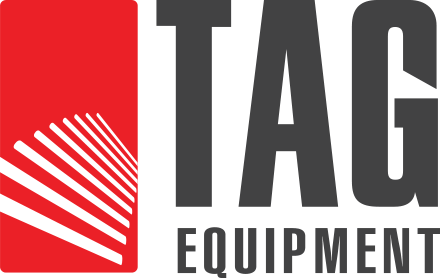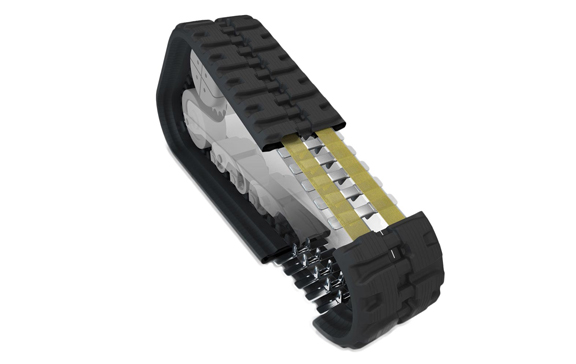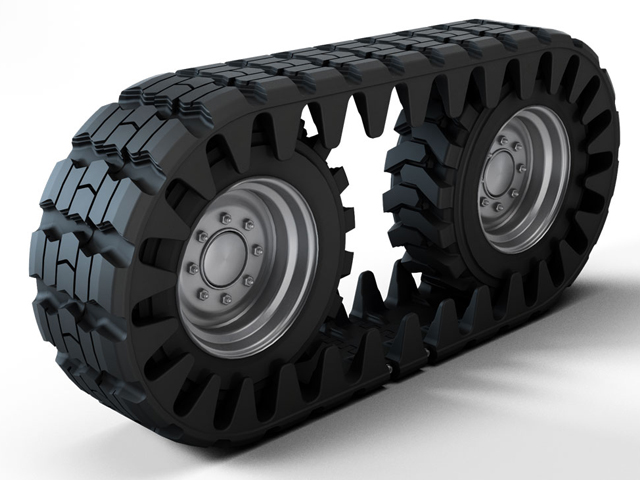If you plan to buy compact equipment or are looking for replacement rubber tracks for skid steers or excavators, it is beneficial to learn about these components. This will help you make the right choice for your application, ensuring less downtime and high productivity. Read on to learn more about rubber tracks and what to consider when purchasing them.
Which Machines are Equipped with Rubber Tracks?
Rubber tracks are commonly used on compact construction equipment such as skid steers, multi-terrain loaders (MTL), compact track loaders (CTL), and mini-excavators. You can also use them on drilling equipment, utility machines, dumpers or track carriers, pavers, and larger compact excavators.
Track Technologies
Rubber Tracks
These are the most common technology powered by the equipment’s undercarriage, similar to their steel counterparts. It consists of a sprocket to transfer engine power, roller wheels to support the machine’s weight, and an idler to maintain track tension.
Over-The-Tire-Tracks
They are a temporary attachment used on wheeled skid steer loaders. OTT is mounted over the equipment’s tires and is a perfect accessory if you need more floatation and traction.
Rubber Pads
It is a relatively new technology typically used for excavators. The three types of rubber pads are bolt-on, clip-on, and chain-on. You can mount the chain-on pads directly on the chain that transfers the engine’s power and either bolt or clip the first two types onto the metal tracks.
Rubber Track Components
- Rubber – is the primary element of a compact equipment track. Buying a heavy-duty carcass helps prevent punctures and ensures longevity.
- Metal Elements – are placed between the rubber surface and underlayer. They help reinforce the carcass and engage with the sprocket to create drive.
- Steel Cord – is placed between the lugs and steel cord. It provides resistance to tension and ensures rigidity along the track’s length.
- Textile Wrapping – is the layer of textile placed between the steel cord and metal elements. It helps ensure consistent steel cord alignment.
Common Rubber Track Problems
When selecting a rubber track, consider the following common issues to avoid expensive breakdowns:
- Poor Durability
Longevity and quality are common risks of buying used rubber tracks. It is wise to buy new ones made using premium rubber compounds and a thick carcass. In addition, consider craft and warranty terms when buying rubber tracks to get your money’s worth. - Poor Traction
It is essential to consider the track’s tread design to select the right one that suits the ground conditions and your application’s requirements. Ask your supplier about the different tread patterns and choose the best one for your machine. - Detracking
This typically occurs when the tracks fall off the undercarriage. Regular inspection and maintenance ensure proper track tensioning and can help avoid detracking. - Inadequate Ride Experience
Some rubber tracks may offer a rougher ride, often leading to excessive noise and vibrations. It is best to discuss purpose-driven tread patterns and operator safety with your dealer when selecting rubber tracks and choose the ones that offer a smooth and silent experience. - Cable Breaking
Steel cables are one of the components of a rubber track. They can sometimes break or snap, causing a breakdown. To avoid this, you can use the ones with endless steel cables and inspect them regularly to check their condition.
Information on the Side of a Track
The side of a rubber track offers many useful details, such as the following:
- Brand name
- Part number
- Serial number (often consists of information about the factory number, year of production, and sequential number)
- Country of origin
Factors Affecting a Rubber Track Durability & Life
Many aspects can potentially impact a rubber track’s longevity and durability.
- Controllable Factors – include track tension, driving speed, the weight of the load, and operator behaviour. You can take preventive measures to avoid downtime because of these aspects.
- Uncontrollable Elements – are commonly linked to the environment, such as temperature and ground conditions. Although you cannot influence these factors, you can work around them by selecting the right track for your application.
Tips to Enhance the Life of Your Rubber Tracks
Operator awareness and proper tension are essential to avoid damage to the undercarriage, tracks, and machine and maximize the track life. Here are some tips to prevent problems that may decrease their longevity and increase the operating costs:
Machine Operation
- Adopt Good Operating Techniques – This includes avoiding overloading, spinning, spot turns, and rough operation on slopes. In addition, ensure minimum contact of the tracks’ side to curb lines and use trailer plates for loading purposes.
- Avoid Abrasive Materials – They tend to cause premature wear of the track’s rubber component. Do not expose them to high heat, broken or sharp rocks, scrap iron, salt, fuel, and oil. If you need to work with such materials, clean the undercarriage thoroughly every day.
Preventive Maintenance
- Correct Tension – Maintain proper track tension and adhere to the instructions by the equipment manufacturer. In addition, ensure even tension on both rubber tracks by driving the machine forward, lowering the bucket to the ground, and using it to lift the front of the compact equipment. Then, measure the distance from the track’s bottom to its inside.
- Regular Maintenance – Inspect your compact equipment’s rubber tracks and undercarriage daily to ensure they are in good condition. Replace damaged or worn parts as soon as possible to prevent mishaps and costly breakdowns.
Get the Best Quality Rubber Tracks for Compact Equipment
Tag Equipment is a leading supplier of high-grade rubber tracks and attachments for compact equipment. We feature a wide range of products by major brands to meet the varied needs of our customers. We offer rubber tracks for the following machines’ makes and models:
- Multi-Terrain Loaders – Camso MTL HXD
- Compact Track Loader – Traxter CTL, Camso CTL SD, Camso CTL HXD
- Over The Tire Tracks – Camso OTT HXD, Camso Steel OTT
- Mini Excavator – Camso MX SD, Camso MX HXD, Traxter MX
- Dumper/Carrier – Camso Carrier HXD
- Paver Tracks – Bridgestone Tracks, Camso Paver Chevron, Camso Paver Smooth
For more details about our inventory of rubber tracks for compact machines, call us at 416-716-5850.


